
http://o.quizlet.com/i/FIimXKB5Je230lGr-TrIqw.jpg

 https://blogger.googleusercontent.com/img/b/R29vZ2xl/AVvXsEjfVOrJqZXET4V2VkbORjgD3Llqq7pldAddNAQS_fPKQUc2yWWqBrXfYqsInOdiQ3kEj8aXg8AifAAXTYP2B2KEOknMLKLqcOl-EGdPUxUszciKjQMG-RqNR82idvBf8HEJ0VrE1tzNByk/s1600/20131106_183055.jpg
https://blogger.googleusercontent.com/img/b/R29vZ2xl/AVvXsEjfVOrJqZXET4V2VkbORjgD3Llqq7pldAddNAQS_fPKQUc2yWWqBrXfYqsInOdiQ3kEj8aXg8AifAAXTYP2B2KEOknMLKLqcOl-EGdPUxUszciKjQMG-RqNR82idvBf8HEJ0VrE1tzNByk/s1600/20131106_183055.jpg
 http://upload.wikimedia.org/wikipedia/commons/9/9a/St%C3%BChle_Froschperspektive.jpg
http://upload.wikimedia.org/wikipedia/commons/9/9a/St%C3%BChle_Froschperspektive.jpg
 http://us.123rf.com/400wm/400/400/tezzstock/tezzstock0804/tezzstock080400015/2951098-female-hand-holding-house-keys-in-front-of-building.jpg
http://us.123rf.com/400wm/400/400/tezzstock/tezzstock0804/tezzstock080400015/2951098-female-hand-holding-house-keys-in-front-of-building.jpg http://farm3.staticflickr.com/2261/2199963241_e995a689c6_o.jpg
http://farm3.staticflickr.com/2261/2199963241_e995a689c6_o.jpg

